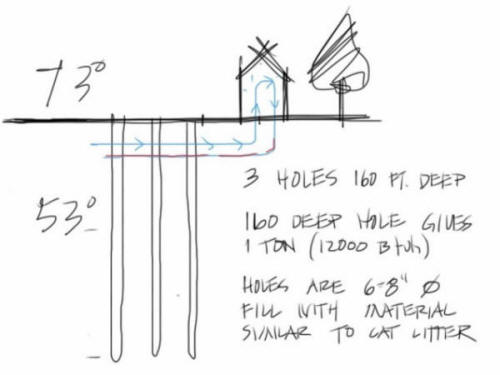Geothermal Energy
Geothermal Energy refers to the process of generating heating and
cooling from the ground. In essence, the process works by capturing
the constant 53 degree temperature of the earth and bringing it to
an occupied space above the ground. For instance, during the heating
season, a geothermal system will work to bring a 53 degree
temperature to the surface thereby reducing the overall load on the
heating system. The same effect is true in the summer where the 53
degree temperature is below the temperature of a hot day. Geothermal systems are generally not able to function as stand alone systems.

The image above is a simple diagram indicating how geothermal heating
works in a building. Once you get to about 4 feet below the ground level,
the temperature of the earth remains constant at around 53 degrees
farenheight (12 degrees Celsius). This means that if it is colder than this
outside (above ground) the heat from the ground can be used to mitigate the
cold. The heat from the ground is captured with water and a mixture of some
sort to help retain the heat (usually glycol). When the water runs through
the pipes, it picks up the heat in the ground which can then be transferred
and used in a building as heat. The opposite is also true when the
temperature outside is warmer. The geothermal system then effectively works
as an air conditioner.
A six inch hole is drilled into the ground to a depth of about 160 feet. From there a 3/4" diameter tube is placed into the hole as a loop. The hole is then filled with nonshrink grout.
As a general rule of thumb, a 160 foot deep hole will provide about 1 ton of cooling (or 12,000 Btuh's).
A house general requires about 1 ton of heating or cooling for every 1000 square feet.
Cost
The big problem with this technology is the cost to install the system
itself. You will need a big truck with a big drill sending a hole down into the
ground in the amount of about 150 feet or so. Anything less than this, generally
proves to be inefficient because the amount of time it takes the water to travel
through the loop is too fast and does not allow for enough time for heat
exchange to occur. This is the effective mechanism at work with this technology
- Heat Exchange. Because the lower ground temperature stays consistent at around
53 degrees, that is the temperature you can achieve with the water tube
system going through the building. For instance, if it is 30 degrees outside,
then the water radiant system, having just returned from a 300 foot trip into
the earth, comes out as 53 degrees. Here is a water pipe filled with water at 53
degrees and it is 30 degrees in here. Therefore, the 53 degree heat from the
tubes will radiate from the pipes because heat always seeks equilibrium. Think
about your cup of coffee. Leave it in the room and it cools off to 'room
temperature'. Same thing for a cold glass of water. Leave it long enough and it
warms up to room temperature instead of cooling down. Distribution of the wealth
in its most natural state.
There are also some other options with Geothermal Energy that include deep water cooling. Here, the same principle is in effect except the temperature difference is changed. The City of Toronto is currently using one of these systems in the bottom of lake Ontario to cool off a
number of downtown office buildings. In essence, a bunch of pipes run to the bottom of Lake Ontario where it is around 4 degrees Celsius. The water is then pushed back up to run through
various coils in a number of buildings. Then everything gets cooled off - and the savings when compared to electricity generated air conditioning are significant.
Unintended Consequences
There is one unintended consequence that may come from underwater cooling projects and mostly, the issue is one of scale. Consider a small deep lake or pond where everyone suddenly has the idea of putting pipes to the bottom of the lake to get their air-conditioning. This would work and it would save on electricity bills. At the same time though, remember that warm water is going back to the bottom of the lake. Now, the natural temperature of the bottom of the lake has become warmer. It is possible that his would have some detrimental impact on the lakes ecosystem if the extent of the change
were significant.
Geothermal Energy is not yet a growth industry but it does have useful applications and there are a number of situations where if you can incorporate it into your designs as an economic and viable resource.